 |  |
"(The Japanese) whose skull pattern being less developed than that of the Caucasians, might be responsible for their aggressive behavior." Franklin Delano Roosevelt, (1942) (Geoffrey S. Smith, "Racial Nativism and Origins of Japanese American Relocation" in: Ed. by Roger Daniels, Sandra Taylor, and Harry Kitano; Japanese Americans, from Relocation to Redress; University of Utah Press; Salt Lake City, Utah; © 1986; 79-85.) |

 WWII Propaganda: The Influence of Racism WWII Propaganda: The Influence of Racismof the Japanese American Internment By Alison Dundes Renteln, Human Rights Quarterly 17.4 (1995) 618-648 by R. Paul Lege, PhD Candidate, University of Phoenix By Geoff Lillich, glillich@vcnet.com, Oxnard Union High School District
"How could such a tragedy have occurred The decision to relocate Japanese Americans raises many compelling questions about the workings of American justice during crisis periods such as World War II. The matter becomes particularly intriguing when considered in light of the fact that, through the entire war, no Japanese American citizen was ever convicted of spying for Japan. Nobody can deny the hardships and humiliations suffered by Japanese Americans as a result of the government's extreme actions; however, a complete explanation of events surrounding this controversial episode must also account for the wartime context in which they occurred. America's war against Japan began with the Japanese bombing of Pearl Harbor on December 7, 1941, and was still being waged in full force when Roosevelt made his fateful decision regarding Japanese Americans in February of 1942. Roosevelt's top priority was winning the war, a view that was shared by an overwhelming majority of Americans. We must remember that the U.S. citizenry, along with those of other allied countries, had every reason to be fearful of Japan because of its military sucesses against us and its alliance with Germany and the other axis powers. This concern prompted Roosevelt to defer to military leaders on an issue which normally would have been decided within the Justice Department. Indeed, the issue of Japanese American internment gave rise to an intense debate that pitted top military men against leaders of the Justice Department who voiced their opposition to the relocation plan in strong terms. |
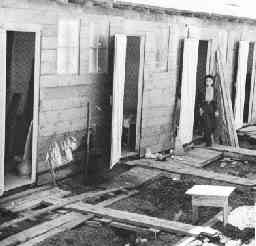 California Polytechnic State University,
California Polytechnic State University,Social Sciences Department, Soc 3l6 American Minorities Dr.Barbara Mori, Study Questions for the Final Exam "(5) The internment of Japanese-Americans during WWII is said to be a constitutional crisis. What aspects of the constitution are threatened? Discuss the internment and the Korematsu, Hirabayashi and Yasui cases in terms of the protections of the constitution and the influence of racism." |
|
The attack of Pearl Harbor opened the flood gates for an attack on Japanese living in America. For years, the Japanese in America had been the target of discrimination. The 1913 Alien Land Law was designed to prevent Japanese from owning land, . . . A computer documentary on the Japanese American internment prison. Contains pictures and discourse about the injustices that occurred there. University of Arizona library presents a photo exhibit on life in Japanese American internment camps. Includes maps and links to other guides. Executive Order No. 9066 issued by President Franklin D. Roosevelt, which ordered the creation of internment camps and the relocation of Japanese Americans and Japanese immigrants. On Internment of Japanese enemy aliens and Japanese-Americans during WW II Confirming the Termination of the Executive Order by Glendale H. Zell II Authorizing Japanese-American Internment During World War II This site presents information on pre-World War II and post-World War II conditions, the politics of internment, the 100th'442nd soldiers, and books on Internment. Maps and diagrams of the Japanese American Internment Camps in the United States. A chronology of the internment of Japanese Americans from 1941-1989. |
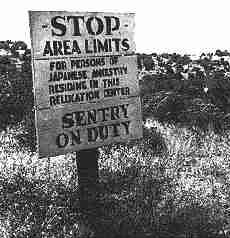
From 1942-1945, in the frenzy and fear of WWII, Manzanar was used as an internment camp for over 10,000 Japanese Americans from Southern California. Water was once again made available and this desert area bloomed. The internees raised produce and brought the fruit
trees back to life. They fed the people in their camp and shipped the excess to other camps in the Western United States. 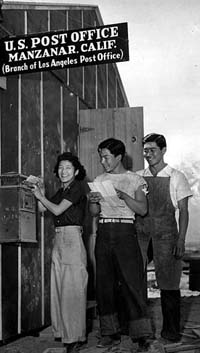
Once a year, on the last Saturday in April, a delegation of Japanese Americans and others make a pilgrimage to Manzanar. A small ceremony is held to pay tribute to the internees and Japanese American veterans who fought in WWII.
Japanese Americans and the United States Constitution 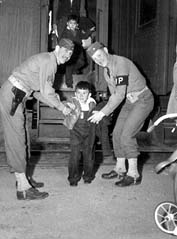 on Internment
on Internment
Arrest, and Internment of internment in the United States Ansel Adams Photographs Internment Camps Curatorial Department from the University of Arizona. (137 K) University of Washington Libraries Yale University Library Microfilm Collections Papers of the U.S. Commission on Wartime Relocation and Internment of Civilians, Part I, Numerical File Archive. (Frederick, MD: University Publications of America Inc., 1984)Microfilm, Government Documents and Information Center GUIDE: Papers of the U.S. Commission on Wartime Relocation and Internment of Civilians. [GDC Ref. D769.8 A6 L47 1] Copyright © 1996 by Yale University Japanese American Community Newspaper The Japanese American Internment Cases Internment of Japanese-Americans, , WWII Security Personnel, Jap-Amer Camps, WWII Military history: |
|
HARBOR BEACH, Mich. (Associated Press) - Justice Frank Murphy of Michigan was among the dissenters when the U.S. Supreme Court upheld the imprisonment of Japanese Americans during World War II. The State Bar of Michigan dedicated a legal milestone Friday in memory of Murphy's dissent. 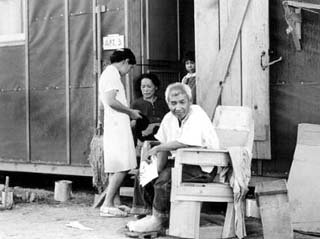 See also:
See also:
in U.S. Democracy For further reading: Peter Irons, Justice at War (1983); Morton Grodzins, Americans Betrayed: Politics and the Japanese Evacuations (1949); Commission on Wartime Relocation, Personal Justice Denied (1983). |
|
Japanese American Internment Memorial Location: East Plaza (located on South 2nd and San Carlos) Robert Peckham Federal Building 280 S. First Street San Jose, CA at War Prison Barracks Three on Fort Douglas and civilian internment in World War One by William B. Glidden from Military Affairs magazine in 1973 and Alien Enemy Internment in the West 1917-1920 First Edition February 1919 #1 Photographs & Drawings
|
 George Takei, best known by fans as the actor who played Mr. Sulu in Star Trek, recently undertook yet another epic journey. This time it was to the World War II internment camp where he spent three years with his family and thousands of other Japanese Americans who were deemed security risks by the U.S. government.
George Takei, best known by fans as the actor who played Mr. Sulu in Star Trek, recently undertook yet another epic journey. This time it was to the World War II internment camp where he spent three years with his family and thousands of other Japanese Americans who were deemed security risks by the U.S. government.
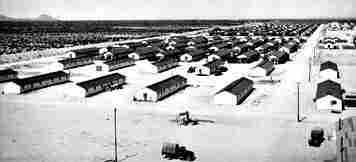 The 1944 high court ruling permitted the forced relocation of 112,000 U.S. residents of Japanese ancestry from their homes on the West Coast to government camps. Murphy disagreed that such internment was a military necessity, calling it "utterly revolting."
The 1944 high court ruling permitted the forced relocation of 112,000 U.S. residents of Japanese ancestry from their homes on the West Coast to government camps. Murphy disagreed that such internment was a military necessity, calling it "utterly revolting."